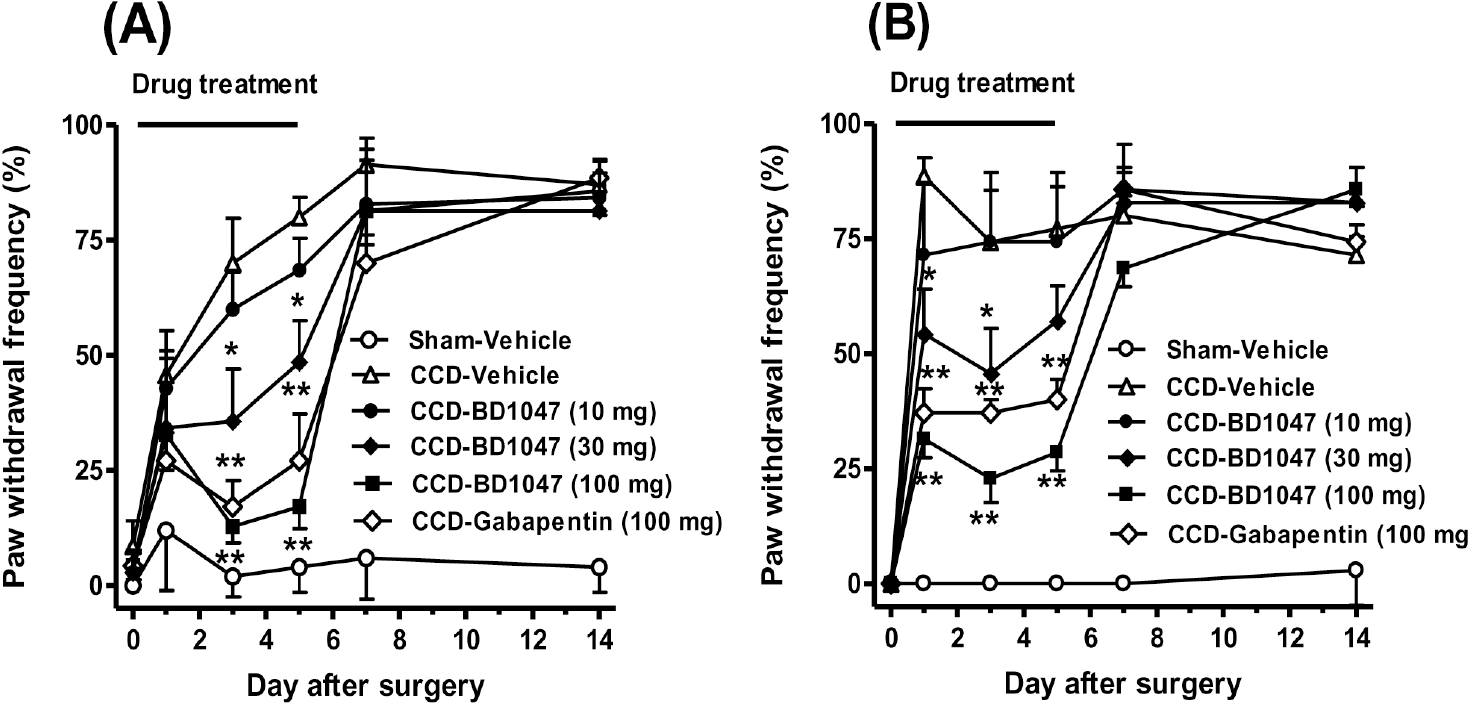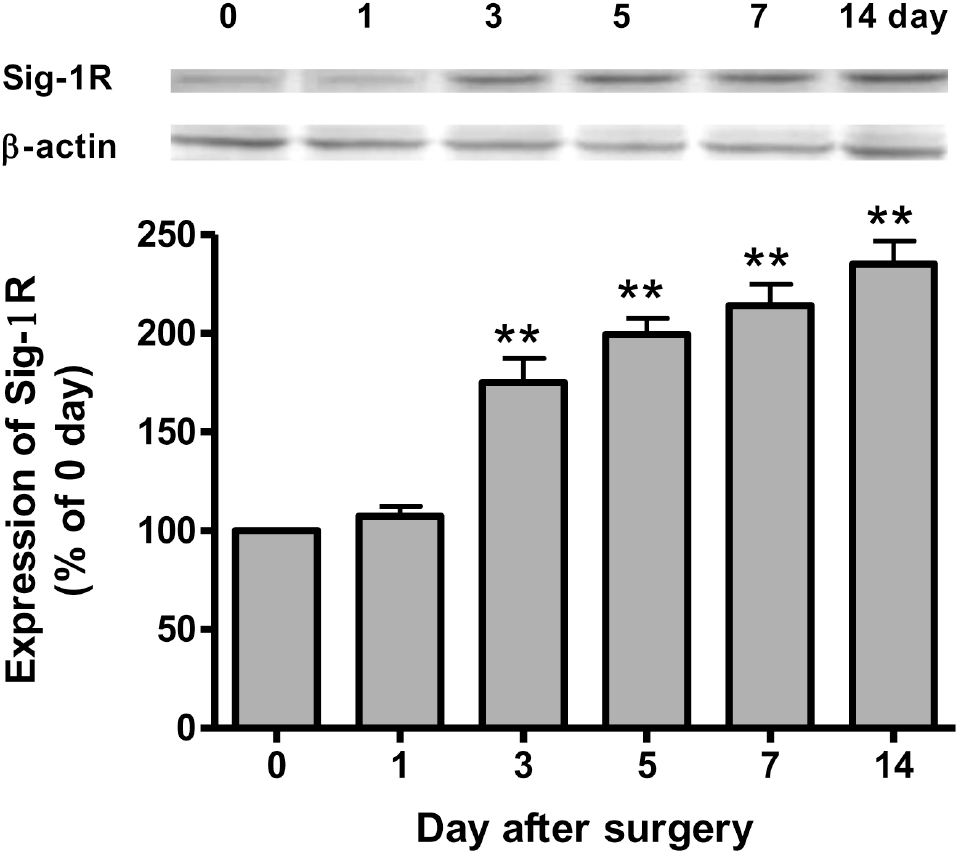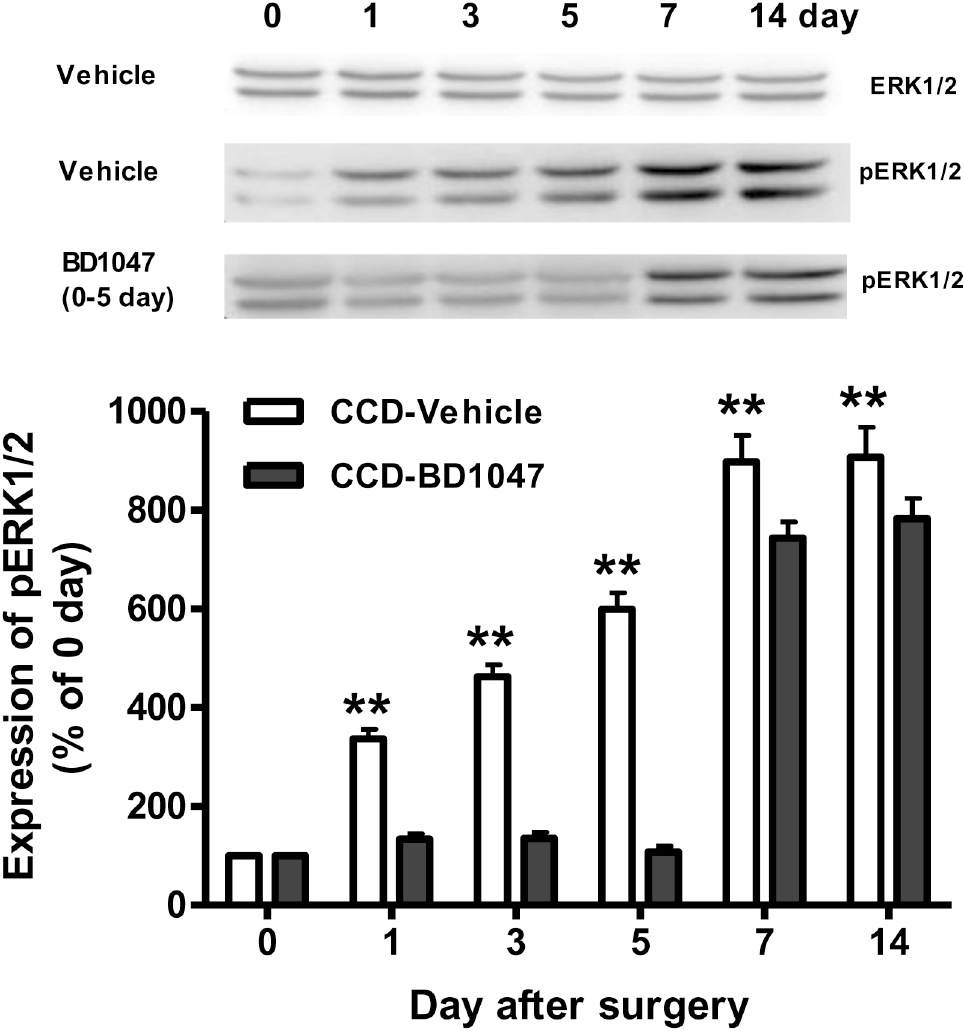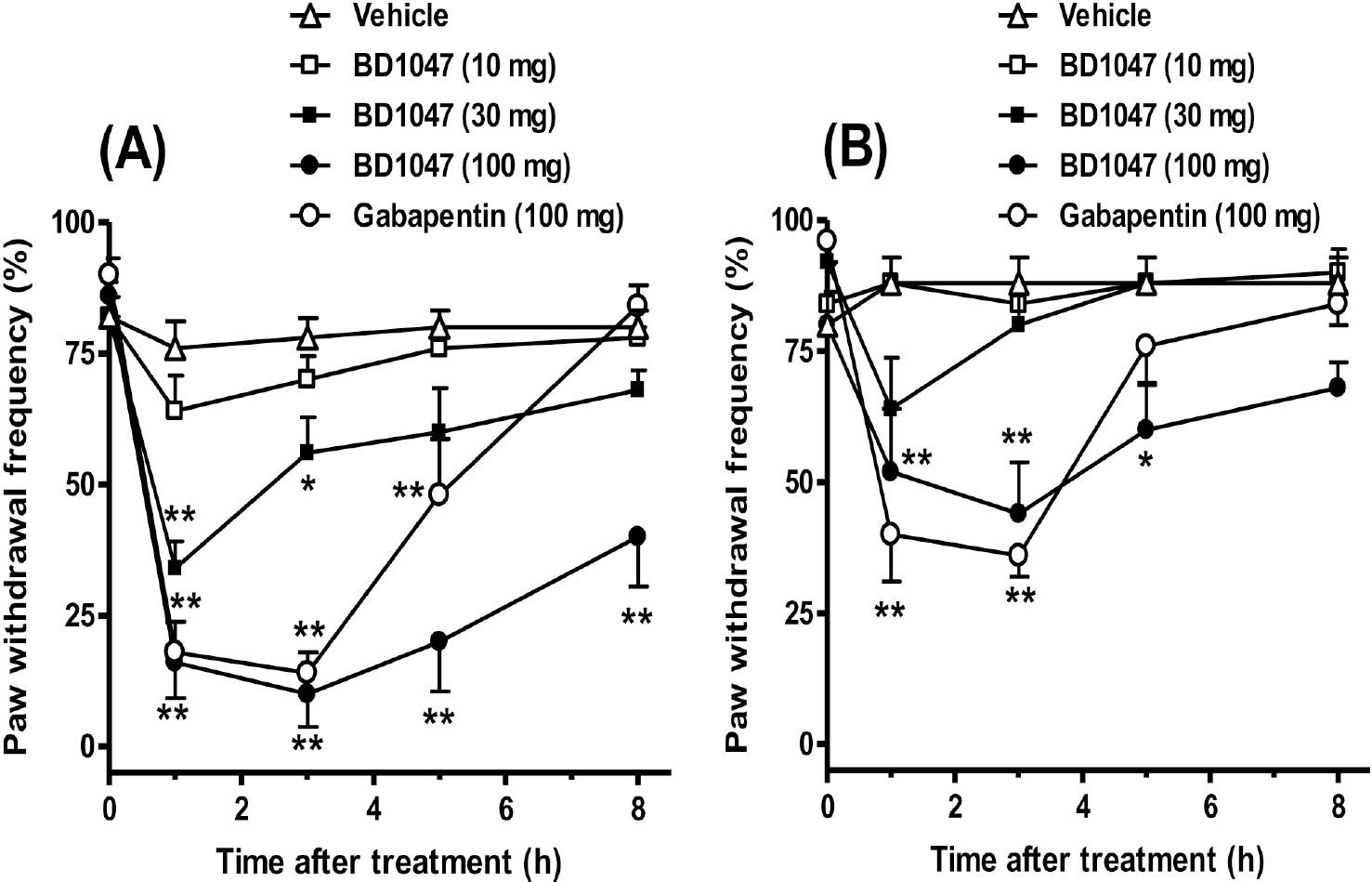Abstract
Many therapeutic roles have been proposed for sigma-1 receptor (Sig-1R), but the involvement of Sig-1R in neuropathic pain has currently not been well explored. The present study aimed to evaluate the anti-nociceptive effect of Sig-1R antagonist (BD1047) in a rat model of chronic compression of the dorsal root ganglion (CCD), which is a model of human foraminal stenosis and radicular pain. When stainless steel rods were inserted into the intervertebral foramen of lumbar vertebrae 4 and 5, the CCD developed reliable mechanical (from 3 day) and cold allodynia (from 1 day) as compared with the sham operation group. The spinal expressions of Sig-1R and phosphorylation of extracellular signal-regulated kinase (pERK) were significantly increased from day 3 to day 14 after CCD surgery, as is consistent with the manifestation of allodynia. The BD 1047 (10, 30, 100 mg/kg) administered on postoperative days 0∼5 dose-dependently suppressed both the induction of allodynia and the elevation of the spinal pERK expression in a manner comparable with that of gabapentin (100 mg/kg). At 7 days post-CCD surgery, BD1047 (10, 30, 100 mg/kg) administration also produced anti-nociceptive effects on the mechanical and cold allodynia similar with those of gabapentin (100 mg/kg). Therefore, this data suggested that Sig-1R may play an important role in both the development and maintenance of CCD-induced neuropathy.
Go to : 
References
2. Cendan CM, Pujalte JM, Portillo-Salido E, Montoliu L, Baeyens JM. Formalin-induced pain is reduced in sigma(1) receptor knockout mice. Eur J Pharmacol. 2005; 511:73–74.
3. Kim HW, Kwon YB, Roh DH, Yoon SY, Han HJ, Kim KW, Beitz AJ, Lee JH. Intrathecal treatment with sigma1 receptor antagonists reduces formalin-induced phosphorylation of NMDA receptor subunit 1 and the second phase of formalin test in mice. Br J Pharmacol. 2006; 148:490–498.
4. Kim HW, Roh DH, Yoon SY, Seo HS, Kwon YB, Han HJ, Kim KW, Beitz AJ, Lee JH. Activation of the spinal sigma-1 receptor enhances NMDA-induced pain via PKC- and PKA-dependent phosphorylation of the NR1 subunit in mice. Br J Pharmacol. 2008; 154:1125–1134.

5. Yoon SY, Roh DH, Seo HS, Kang SY, Han HJ, Beitz AJ, Lee JH. Intrathecal injection of the neurosteroid, DHEAS, produces mechanical allodynia in mice: involvement of spinal sigma-1 and GABA receptors. Br J Pharmacol. 2009; 157:666–673.
6. Kibaly C, Meyer L, Patte-Mensah C, Mensah-Nyagan AG. Biochemical and functional evidence for the control of pain mechanisms by dehydroepiandrosterone endogenously synthesized in the spinal cord. FASEB J. 2008; 22:93–104.

7. de la Puente B, Nadal X, Portillo-Salido E, Sanchez-Arroyos R, Ovalle S, Palacios G, Muro A, Romero L, Entrena JM, Baeyens JM, Lopez-Garcia JA, Maldonado R, Zamanillo D, Vela JM. Sigma-1 receptors regulate activity-induced spinal sensitization and neuropathic pain after peripheral nerve injury. Pain. 2009; 145:294–303.
8. Roh DH, Kim HW, Yoon SY, Seo HS, Kwon YB, Kim KW, Han HJ, Beitz AJ, Na HS, Lee JH. Intrathecal injection of the sigma(1) receptor antagonist BD1047 blocks both mechanical allodynia and increases in spinal NR1 expression during the induction phase of rodent neuropathic pain. Anesthesiology. 2008; 109:879–889.
9. Huang ZJ, Song XJ. Differing alterations of sodium currents in small dorsal root ganglion neurons after ganglion compression and peripheral nerve injury. Mol Pain. 2008; 4:20.

10. Ji RR, Gereau RW 4th, Malcangio M, Strichartz GR. MAP kinase and pain. Brain Res Rev. 2009; 60:135–148.

11. Ma W, Quirion R. Partial sciatic nerve ligation induces increase in the phosphorylation of extracellular signal-regulated kinase (ERK) and c-Jun N-terminal kinase (JNK) in astrocytes in the lumbar spinal dorsal horn and the gracile nucleus. Pain. 2002; 99:175–184.

12. Ma C, LaMotte RH. Multiple sites for generation of ectopic spontaneous activity in neurons of the chronically compressed dorsal root ganglion. J Neurosci. 2007; 27:14059–14068.

13. Coderre TJ, Kumar N, Lefebvre CD, Yu JS. Evidence that gabapentin reduces neuropathic pain by inhibiting the spinal release of glutamate. J Neurochem. 2005; 94:1131–1139.

14. Werner MF, Kassuya CA, Ferreira J, Zampronio AR, Calixto JB, Rae GA. Peripheral kinin B(1) and B(2) receptor-operated mechanisms are implicated in neuropathic nociception induced by spinal nerve ligation in rats. Neuropharmacology. 2007; 53:48–57.

15. Zhuang ZY, Gerner P, Woolf CJ, Ji RR. ERK is sequentially activated in neurons, microglia, and astrocytes by spinal nerve ligation and contributes to mechanical allodynia in this neuropathic pain model. Pain. 2005; 114:149–159.

16. Ma W, Quirion R. The ERK/MAPK pathway, as a target for the treatment of neuropathic pain. Expert Opin Ther Targets. 2005; 9:699–713.

17. Dubrovsky BO. Steroids, neuroactive steroids and neurosteroids in psychopathology. Prog Neuropsychopharmacol Biol Psychiatry. 2005; 29:169–192.

Go to : 
 | Fig. 1.Repeated daily (from days 0 to 5) oral administration of BD1047 (10, 30, 100 mg/kg) or gabapentin (100 mg/kg) prevented mechanical allodynia (A) and cold allodynia (B) following chronic compression of dorsal root ganglion (CCD). ∗p <0.05, ∗∗p<0.01 compared to CCD-Vehicle group. Each group contains 7 animals. |
 | Fig. 2.Western blotting analysis illustrating the change of sigma-1 receptor (Sig-1R) expression in the ipsilateral dorsal quadrant of L4-L6 spinal cords after following chronic compression of dorsal root ganglion (n=5 at each time point). ∗∗p<0.01 compared to control group (0 day). |
 | Fig. 3.Western blotting analysis of the effect of daily BD1047 treatment (100 mg/kg, 0∼5 day) on chronic compression of dorsal root ganglion (CCD) induced ERK1/2 expression and phosphorylated ERK1/2 (pERK) in the ipsilateral dorsal quadrant of L4-L6 spinal cords (n=5 at each time point in each group). ∗∗p<0.01 compared to control group (0 day). |




 PDF
PDF ePub
ePub Citation
Citation Print
Print



 XML Download
XML Download